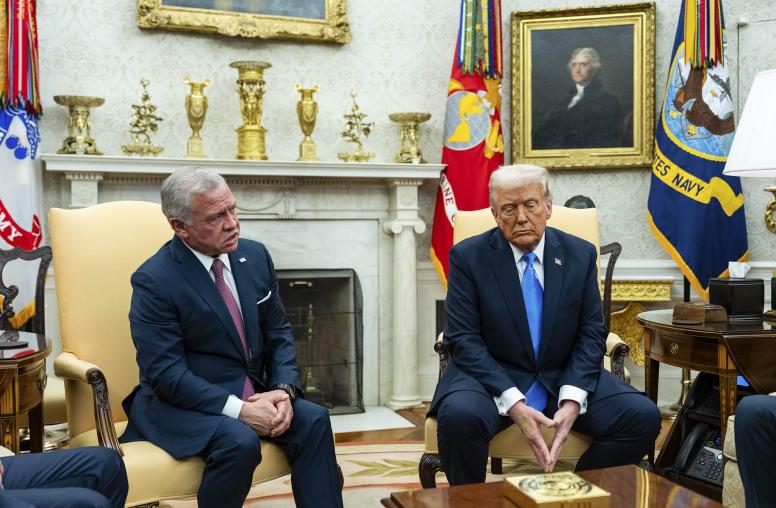As Vice President Pence Visits the Middle East, Hopes for Diplomacy Languish
Leaders have closed the old paths toward peace, and offered no new ones
Vice President Mike Pence heads to Egypt, Jordan and Israel with little diplomatic quiet, and even less hope, on the Israeli-Palestinian front. President Abbas has declared the Oslo peace process dead, and the United States mediating role over, President Trump has broken with international consensus on Jerusalem, and pointedly not endorsed a two-state solution since coming to office, and Prime Minister Netanyahu has now hedged on his commitment to the end goal of a Palestinian state.

There is common ground here: a shared rejection of the assumptions of the past quarter-century of diplomacy on this issue, paired with a shared choice or inability to articulate an alternative way forward that can offer a sustainable solution to this conflict. Absent a political horizon, the situation on the ground, and the prospects for a successful return to diplomacy, risk irreversible deterioration.
Mutual Rejection
Abbas has not rejected the two-state solution. In fact, even amid a fiery and provocative speech to the Palestinian Central Council last Sunday, he continued to endorse pursuit of a Palestinian state “in the ’67 borders with a capital in East Jerusalem.” And while forcefully rejecting a U.S. role as exclusive mediator, he expressed a willingness to continue negotiations under an international umbrella and denounced terrorism. He also noted that the Palestinian Authority maintains an office devoted to outreach to the Israeli public. But concrete policy pronouncements and strategic direction were missing from the speech, shedding little light on what a “dead Oslo” now means in practical terms.
Meanwhile, Netanyahu has seized on the divisive rhetoric in Abbas’s speech to assert that Abbas has thereby revealed Palestinians to be the true obstacle to peace. Politicians to his right are openly pushing an annexationist goal, while Netanyahu himself has yet to offer a definitive view, or a long-term plan and vision for an Israel in potential perpetual control of a Palestinian population that is roughly equal in size to its own Jewish citizenry.
This lack of clarity mirrors a challenge posed by President Trump who, in early December, officially recognized Jerusalem as Israel’s capital, noting that it was a “long overdue step to advance the peace process.” Yet here too, no specifics have been revealed that connect the dots from that announcement to a plan to bring about an “ultimate deal.”
Vice President’s Trip
What does this mean for the vice president’s trip agenda?
Notably, the official announcement of his trip downplayed Israeli-Palestinian peace as a focal point, and emphasized an agenda devoted to strengthening cooperation with regional allies on such issues as combatting terrorism.
The Palestinian leadership has refused to meet with the vice president, following December’s Jerusalem announcement, and the Egyptian and Jordanian leadership now find themselves in the delicate position of needing to work with the U.S. on shared security issues, while anger directed at the U.S. grows on their own streets.
In recent days, the United States has announced it is withholding its regular contributions to UNRWA, the United Nations agency that assists Palestinian refugees. That has only brought more attention to the growing strain in U.S.-Palestinian relations on the eve of Pence’s trip: a particular challenge to Jordan, which is one of UNRWA’s five areas of operation, and where a large proportion of the country’s population is of Palestinian origin.
As much as the vice president may want to keep the focus on shared interests beyond the Israeli-Palestinian conflict, King Abdullah of Jordan, and President Al-Sissi of Egypt, will be hard pressed not to address, and take a hard line on, the trajectory of U.S. engagement on this issue.
Pence in Jerusalem
Pence will likely receive a warm welcome at his last stop in Israel, where he will speak at the Knesset, and visit the Jewish holy site of the Western Wall in the Old City of Jerusalem. However, this itinerary opens the door to fanning the flames around the Jerusalem issue, and the vice president has a tough diplomatic tightrope to walk if he seeks to reaffirm key alliances in the region, and to minimally “do no harm” in the Israeli-Palestinian context.
Since the Jerusalem announcement in December, U.S. administration officials have talked about the need to allow the Palestinians a “cooling-off period” before returning to talk of their peace plan. The rhetoric and developments of the past few weeks, however, have done nothing to damp the flames.
The administration’s peace plan is reported to be forthcoming. If this is a plan designed to address the interests of both sides, the sooner it is presented the better. Public opinion polls over many years have consistently indicated that when there is political leadership, vision, and hope for progress, Israeli and Palestinian support for a peace deal is high.
The onus is equally on the Israeli and Palestinian leadership to stop falling back on what is not possible, without affirmatively presenting a clear and viable vision for the future, and a detailed proposal for how it can be achieved. The more time that passes without a political vision, the more opportunity there is for the void to be filled with rumor, speculation, despair, and ultimately violent repercussions.



